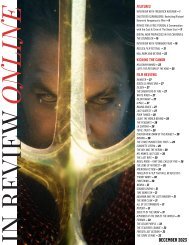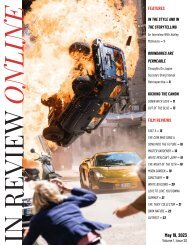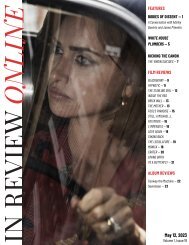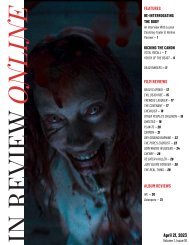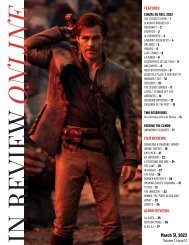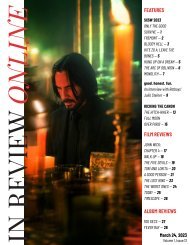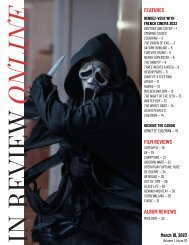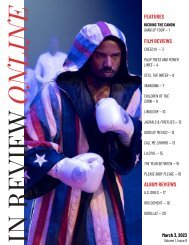You also want an ePaper? Increase the reach of your titles
YUMPU automatically turns print PDFs into web optimized ePapers that Google loves.
MORVERN CALLAR<br />
Lynne Ramsay<br />
“READ ME”: a visage<br />
lit in orange glow, hands, bodies,<br />
hands caressing bodies, the twinkling lights of a Christmas tree, the two words blinking mutely from a desktop screen,<br />
silence. So opens <strong>—</strong> in oneiric, inert fashion <strong>—</strong> Morvern Callar, a palimpsest of orange, beige, and grayscale, set to the disquieting rhythm<br />
of a society whose margins aren’t quite defined, perhaps not definable, whose success stories overwhelm the silent failures amidst<br />
them. Morvern Callar (Samantha Morton), a supermarket clerk, is one such failure, working dead-end retail at the age of twenty-one and<br />
betrothed to her recently deceased boyfriend, a writer leaving behind a hole to his head, his corpse on the apartment floor, a copy of his<br />
manuscript, and his suicide note which beckons: “READ ME.” These two words, appearing only fleetingly, arguably constitute the film’s<br />
clarion call to the viewer, an injunction for the bourgeois outsider to peer into, and find poetry in, the lives of their poorer others.<br />
1
But what, or who, is there to be read? Lynne Ramsay, in just her<br />
second feature, establishes a mature tonal register far beyond<br />
the purview of most sophomore efforts. Poetic realism, as Renoir<br />
or Vigo would have it, has witnessed a comeback in British<br />
cinema under Tony Blair, somewhat distinct from the kitchen-sink<br />
variety fostered by Ken Loach and Mike Leigh insofar as the<br />
latter’s socialist roots are now imbued with a lyricism heavily<br />
indebted to the tactile screen: shots of objects and household<br />
minutiae in focus, their coarse, lived textures reclaimed by the<br />
gently gliding lens, as in the pair of glasses sitting morosely at<br />
the bottom of a canal in Ramsay’s debut Ratcatcher or in the dingy<br />
poverty of an apartment interior, lit by the light of summer, in<br />
Andrea Arnold’s Fish Tank. In Morvern Callar, silence complements<br />
these shots, rendering them still; like still life, an aura pervades<br />
through the celluloid, resisting the medium’s mechanically<br />
reproducible images by imprinting some trace of historicity to its<br />
objects and some glimpse of psychological interiority to its people.<br />
Ramsay’s Morvern takes to the exotic environs of Spain soon after<br />
her boyfriend’s death, seeking to rediscover herself and rechart the<br />
course of her life. But paradoxically, her mobility on the road is<br />
matched by her aimlessness, a stasis that takes flight in both her<br />
head and our own as we navigate the dim alleys of Scotland, before<br />
wandering the Andalusian desert, alongside Morvern and her<br />
co-worker and best friend Lanna (Kathleen McDermott). Struggling<br />
to articulate her thoughts in words, Morvern translates them into<br />
action: she passes off her boyfriend’s manuscript as her own,<br />
feigning aloof innocence in front of her prospective publishers<br />
who’ve traveled down to Spain to meet her, and she hooks up at the<br />
hotel with a man who’s just lost his mother. All of these little<br />
impulses <strong>—</strong> transient, mysterious, ambivalent <strong>—</strong> are keenly<br />
immortalized under Ramsay’s watchful, loving gaze and afforded<br />
symbolic eminence in lieu of overt political commentary. Little<br />
exposition or contextualization is deemed necessary in her case;<br />
the focus lies, instead, with Morvern’s deeply subjective<br />
2
experience, a heartfelt struggle to comprehend (or simply exist in)<br />
a world in which grief and futility have assumed near-total control.<br />
an uneasy dynamic between filmmaker and filmed reinscribed into,<br />
and thus neutered by, the distractions of film grain.<br />
Therein lies the filmmaker’s creative mark and also marked<br />
curse: for all her earnest and perspicuous examination of the<br />
outsiders in an otherwise globalized suburbanity, Ramsay’s<br />
works bear her worst tendencies of mistaking the abstruse for<br />
the profound, of fomenting aestheticized sympathy where<br />
contradictions and lived reality do more justice to the<br />
constituents of her gaze. Ratcatcher’s exhumation of workingclass<br />
squalor in 1973 Glasgow, for example, tempers realism with<br />
the coming-of-age imagination of twelve-year-old James<br />
Gillespie, effectively allowing misery-laden stereotypes of<br />
wayward youth to puncture and permeate the narrative under<br />
the guise of impressionism; We Need to Talk About Kevin, her<br />
follow-up to Morvern Callar, similarly banks on Ezra Miller’s<br />
unknowable, abject tour de force to elicit one-dimensional<br />
fascination toward its eponymous character. The critical debate,<br />
despite consensus toward praise, has always centered around<br />
the politics of representation: does Ramsay empower the working<br />
class through her compositions, or does she inadvertently<br />
romanticize their struggles and attitudes? It’s a question that her<br />
elliptical, shadowy evocations of milieus tend shy away from,<br />
Armond White’s description of Ratcatcher <strong>—</strong> as emblematic of a<br />
“Boutique Socialism” <strong>—</strong> demonstrates, for all its loaded antipathy<br />
for the latter term, a cultural acquiescence toward poverty as<br />
refracted through the lens of unfiltered film photography. With<br />
Morvern Callar, Ramsay’s ideological engagements are spelt out;<br />
rather than politicizing the margins, she displays a penchant for<br />
poeticizing them. The subtexts of its relationships <strong>—</strong> Morvern and<br />
her boyfriend, Morvern and Lanna, Morvern and the publishers <strong>—</strong><br />
are present, but defiantly couched within interpretations just out of<br />
reach. We wager Morvern’s unequal, unhappy life under the<br />
influence of an intellectual, we posit her willingness to take credit<br />
for his work as confused, vengeful, or simply lazy opportunism.<br />
There’s no denying the indelible impact of poetry, written or visual,<br />
but in this case the marriage between both forms is itself unequal:<br />
the latter’s spontaneity foiled by the former’s scarcity. Ultimately,<br />
the bitter taste that remains after the reading, whether for Morvern<br />
or for us, curdles into flattened sympathy. That, for better or for<br />
worse, is Ramsay’s acclaim in poetry and realism, two fields whose<br />
crops cannot both aspire to the same fecundity but have, thanks to<br />
her, done so. <strong>—</strong> MORRIS YANG<br />
3
KICKING THE CANON<br />
THE DEVIL’S REJECTS<br />
Rob Zombie<br />
When Rob Zombie's House of 1000 Corpses was released in 2003 (following numerous distribution delays by its original producer<br />
Universal Studios due to objectionable content), many chalked it up to the vanity project of a rockstar. Zombie, after all, had made his<br />
name first with the band White Zombie and then as a solo artist, mixing and matching classic horror movie monsters, Max Fleischer<br />
cartoons, The Munsters, and Alice Cooper into a heady stew. He was part carnival barker, part unhinged sociopath, part Stan Lee, always<br />
ready to proselytize for old B-movies and the sort of bric-a-brac that accompanies Halloween funhouses. Corpses became notable<br />
mostly for casting future pop-culture mainstays Chris Hardwick and Rainn Wilson in early roles and for its bald-faced liftings from Tobe<br />
Hooper's The Texas Chain Saw Massacre parts 1 & 2, leading to a mildly diverting horror oddity that couldn't quite overcome Zombie's<br />
fanboyish adoration of ‘70s genre classics.<br />
4
Sullivan. Roy (Geoffrey Lewis) and Adam (Lew Temple) have the<br />
grave misfortune of falling for Baby's honeypot routine while<br />
their wives, Gloria (Priscilla Barnes) and Wendy (Kate Norby),<br />
lounge around in their room. Once the men invite Baby in, Otis<br />
makes his presence known and a sick game ensues, the two<br />
psychopaths playing with their victims like malicious children<br />
pulling the wings off insects.<br />
Any other filmmaker would make this extended set piece the<br />
climax of their movie, an extended bit of extremely unpleasant<br />
torture and sexual mortification that leads ultimately to the<br />
death of each hostage. But this is only the halfway point of The<br />
Devil's Rejects, as Zombie spends the second half of the film<br />
slowly reconfiguring the remaining Firefly crew from antagonists to<br />
protagonists, allowing them the status of romantic, mythical rebels<br />
and outlaws. It's a bold gambit, facilitated by Sheriff<br />
Wydell's simultaneous transformation from lawman to killer as<br />
he seeks revenge for the death of his brother (a previous victim<br />
of the Firefly’s, as detailed in Corpses). Wydell eventually murders<br />
Mother Firefly in cold blood, then hires a couple of ex-con<br />
mercenaries to capture Baby, Otis, and Spaulding. The on-screen<br />
representative of “law and order” fully becomes that which he is<br />
hunting, abdicating his moral authority in the process and<br />
granting the Firefly's a patina of righteous fury as they now<br />
fight for their own lives.<br />
In their exhaustive, 10-part essay series from 2022 titled The End<br />
of History, an extremely detailed examination of the films of Tony<br />
and Ridley Scott as they relate to the death of a certain kind of<br />
American mainstream cinema, filmmakers Scout Tafoya and<br />
Tucker Johnson devote Chapter 6 to the aftermath of 9/11 and its<br />
pernicious influence on U.S. popular culture. It's a positively<br />
Hoberman-esque bit of provocation, making connections<br />
between the rise of the surveillance state, the dampening of<br />
dissent amongst journalists and artists, the worrisome rallying<br />
behind the U.S. war machine, and particularly the haunting<br />
images that came out of Abu Ghraib in 2004. It’s a fascinating<br />
(and reasonably convincing) series of linkages; Tafoya and Johnson<br />
speculate that the American media's failure to deal with this<br />
atrocity created a rift of sorts, leading to a rise of extreme<br />
horror films that, in their words, were “the only images that<br />
commented on America's uncontrollable bloodlust.” There's no<br />
indication that Zombie is particularly political, nor would anyone<br />
accuse him of being an intellectual, and yet astute critics at the<br />
time recognized in films like Hostel and The Devil's Rejects clear<br />
allusions to the Abu Ghraib photographs. Willow Catelyn Maclay,<br />
perhaps our finest critic on Zombie's body of work, puts it more<br />
succinctly: 'In Zombie's films, death matters.” The suggestion being,<br />
clearly, that in other genre films, and perhaps in life, death is<br />
purely abstract (not for nothing are most people's memories of the<br />
wars in Iraq and Afghanistan largely impersonal, long-distance,<br />
night-vision images that look more like video games than battle<br />
zone footage).<br />
In his seminal 1970 collection Hollywood from Vietnam to Reagan,<br />
Robin Wood writes on the idea of the “incoherent text” that<br />
“moves[...] toward an unresolvable and usually unrecognized<br />
dilemma, both the incoherence and the dilemma become in<br />
themselves eloquent, speaking for the quandary of a civilization.”<br />
Zombie taps into this eloquence in an intuitive way, in the sense<br />
that he seems to genuinely love the monsters he has created and<br />
can only bring himself to vanquish them in a kind of heroic blaze of<br />
glory. The Rejects driving into a hail of bullets while Lynyrd<br />
Skynyrd's “Freebird” blares on the soundtrack is as deranged a<br />
summation of America as one is likely to muster, murderers and<br />
rapists romanticized into oblivion by the forces of law and order<br />
that are in fact just as evil as the predators they purport to protect<br />
us from. As writer Mike Thorn says, it’s a “vital American movie,<br />
made of the very same iconography and textures that it burns to<br />
the fucking ground.” This is our 21st-century The Wild Bunch. <strong>—</strong><br />
DANIEL GORMAN<br />
KICKING THE CANON<br />
“The Rejects driving into a hail<br />
of bullets while Lynyrd<br />
Skynyrd's “Freebird” blares on<br />
the soundtrack is as deranged<br />
a summation of America as one<br />
is likely to muster.<br />
6
FILM REVIEWS<br />
PLANE<br />
Jean-François Richet<br />
While the ongoing Liam Neeson dad-action-movie concern has<br />
been producing ever more diminishing returns, over the last<br />
decade and change, just about nobody has so consistently provided<br />
sturdy B-movie thrills on the level of Gerard Butler. Year after year,<br />
he dutifully and enthusiastically turns out the kind of mid-range,<br />
violent thrillers that used to be hitting theaters once<br />
a week in the 1990s. From the deeply silly … Has Fallen series to<br />
the impending apocalypse of Greenland or the surprisingly epic<br />
Heat ripoff Den of Thieves, the sign of an upcoming low-rent<br />
Butler actioner has become legitimate cause for excitement.<br />
His latest is no exception. Butler plays Captain Brodie Torrance,<br />
a widowed commercial pilot with Trailblazer airlines, tasked with an<br />
overnight New Year’s Eve flight from Singapore to Tokyo, after<br />
which he’ll be headed to Hawaii to spend the holiday with his<br />
daughter. Hopefully the lightning storm he’s been ordered to fly<br />
through won’t cause any trouble… whoops, no, there’s a crash<br />
landing on a remote island, which turns out to be a haven for<br />
Filipino separatists and drug traffickers who like to ransom their<br />
kidnap victims, and it’s up to Captain Torrance to save the day. Did<br />
I mention that this movie is called Mayday? No, I didn’t, because it’s<br />
brilliantly just called Plane. Also on board is Louis Gaspare (Mike<br />
Colter), a fugitive who’s headed back to the states for extradition<br />
and who has a very conveniently helpful background as a Foreign<br />
Legionnaire. Together, Torrance and Gaspare have to infiltrate the<br />
enemy stronghold, rescue the passengers, and somehow get off<br />
the island to safety. Meanwhile, a couple of big wheels over at the<br />
airline (Paul Ben Victor and Tony Goldwyn) are in a command<br />
center ordering up a team of private mercenaries to locate the<br />
plane and parachute in for a hot extract.<br />
The siege setup and relationship between the two uneasy partners<br />
recalls nothing short of Carpenter’s legendary Assault on Precinct<br />
13, and while Plane predictably doesn’t rise to anywhere near those<br />
heights, it’s never less than a fully amusing and wholly engaging<br />
7
FILM REVIEWS<br />
affair. It may not be original, but it hits every single beat it needs<br />
to, from the opening act’s introduction of a motley gaggle of<br />
passengers and crew (the grouchy rich guy, the cute girl tourists,<br />
the plucky flight attendant, etc.), to a harrowing crash sequence,<br />
to Torrance’s selfless hero’s quest to care for his flock. Butler<br />
himself is firing on all cylinders here; his Dad energy is confident<br />
but quietly terrified. Even though he and we know that he’s in over<br />
his head, watching him swim around in all that emotion while still<br />
kicking appropriate amounts of ass is a blast the likes of which<br />
we rarely get anymore.<br />
Once the third-act action kicks in, Plane realizes its full potential.<br />
Director Jean Francois-Richet (who coincidentally helmed the<br />
2005 Precinct 13 remake) stages the action cleanly and clearly,<br />
even though the handheld can be a little too much to handle<br />
sometimes. The plane crash itself is appropriately exciting, and<br />
a fun mid-movie fistfight comes off in a single wobbly take, but<br />
the mercenary- assisted breakout-and-escape finds the film’s<br />
peak in a rising and violent climax. Especially appreciated here<br />
is a gag involving what a .50 caliber sniper round does to a<br />
human body, something that gets repeated four or five times<br />
(and frankly, that’s not enough). A delightful example of a movie<br />
doing exactly what it promises with absolutely no frills or<br />
pretense, Plane is the kind of movie that should be coming out<br />
twice a month. <strong>—</strong> MATT LYNCH<br />
DIRECTOR: Jean-François Richet CAST: Gerard Butler, Mike Colter,<br />
Paul-Ben Victor, Tony Goldwyn, Yoson An, Lily Krug DISTRIBUTOR:<br />
Lionsgate IN THEATERS: January 13 RUNTIME: 1 hr. 47 min.<br />
WILDCAT<br />
Melissa Lesh, Trevor Frost<br />
Premiering at the 2022 edition of the Cannes Film Festival and<br />
dropping into U.S. theaters in the autumn, Jerzy Skolimowski’s EO<br />
was a film that challenged both our notions of the “animal movie” at<br />
large and how we assemble and contort images into tidy, digestible<br />
narratives, no matter how antithetical to the visual media itself that<br />
may be. The director took care to move away<br />
from the default anthropomorphism that so many such films are<br />
lathered in, rejecting the easy metaphors typically used to<br />
engender human empathy in viewers by appealing to their<br />
instinctive homocentrism (, and instead attempting to imagine and<br />
explore an alien umwelt, abstracting his images more and more as<br />
the film moves forward, refusing any easy thematizing in EO’s<br />
beguiling spaces. Into that sphere comes another faunal work that<br />
sneakily subverts expectations of form: Melissa Lesh and Trevor<br />
Frost’s Wildcat.<br />
Though predictably less experimental than Skolimoswki’s film, the<br />
directorial duo’s debut effort is still a challenging work in its own<br />
right, assuming the superficial posture of an animal or nature<br />
documentary but shedding all of that subgenre’s most irksome<br />
trappings. This is especially surprising given a logline that is rich in<br />
potential for the saccharine: Harry Turner, a young British soldier<br />
back from active duty in the Middle East and suffering from PTSD,<br />
heads into the Peruvian Amazon as a kind of escape (and informed<br />
by Fawcettian notions of romantic adventure). Once there, he<br />
meets Samantha Zwicker, a young American grad student<br />
spearheading a wildlife rescue and rehabilitation effort, strikes up<br />
a relationship with her, and begins caring for an orphaned baby<br />
ocelot. But rather than entering into some canned arc of mutual<br />
salvation between man and beast, Wildcat succeeds by allowing its<br />
intimacies and conflicts and tragedies to unfurl organically. It’s a<br />
thrillingly destination-ambivalent work in its linearity, its “story”<br />
revealing itself in real-time and recalling something like Minding the<br />
Gap, where emotion is earned through the edit’s construction rather<br />
than any overriding or predetermined intent. It’s exploratory in the<br />
best and rarest sense.<br />
No small part of this is thanks to the film’s production. Wildcat leans<br />
further into the ethics of animal science than your average film of<br />
this ilk, both discursively <strong>—</strong> those fluent in the writings of Frans de<br />
Waal and Ed Yong (and EO, for that matter) will be familiar with the<br />
documentary’s comfort in nature’s mysteries and its refusal to<br />
ascribe human agenda to animals <strong>—</strong> and in the filmmaking process,<br />
which barred Lesh and Frost from proximity to the ocelots, leaving<br />
Turner and Zwicker to capture much of the<br />
8
FILM REVIEWS<br />
film’s footage, guide its rhetoric, and navigate the murky terrain of<br />
on-screen self-reflexivity. Again, as in Minding the Gap, this<br />
naturalism works to build a profoundly affecting emotional core,<br />
which in turn operates as a ballast for the film’s amorphousness<br />
and thesis-agnostic approach. That doesn’t mean Wildcat is without<br />
ideas: the film’s very synopsis suggests the seed of an notion about<br />
humanity’s essential cruelty, as it extends to animals, the natural<br />
world, and other people, and the filmmakers subtly but poignantly<br />
allow this to mature through the film’s edit, refusing histrionics and<br />
arch narrativization in favor of small moments of brokenness and<br />
healing, joy and despair, callousness and care, all cocktailed into a<br />
moving, deceptively vast, and, ideally, perspective-shifting study in<br />
our collective responsibility to the world, each other, and ourselves.<br />
In a documentary film landscape ever more engineered toward<br />
biography and “essay” in form and true crime and social causes in<br />
content, a trend only further enunciated by the age of streaming<br />
we’re living through, the market has been flooded with prefab films<br />
of easy topicality, buzzword baiting, and baseline competence,<br />
most with very little visual appeal or intellectual heft to speak of.<br />
Wildcat is a wondrous respite from such trite and calculated<br />
offerings; it even has the confidence and conceptual restraint to<br />
resist plaguing its frames with unnecessary aestheticizing or<br />
arbitrary images of Amazonian grandeur, with Lesh and Frost<br />
understanding the fundamental intimacy and modesty of their<br />
film’s foci. (Drilling down to the slightly more niche, Wildcat’s title<br />
also amusingly offers something of a middle finger to the similar<br />
minimalism employed by DisneyNature for the works they assembly<br />
line out to the public <strong>—</strong> Penguins, Elephant, Polar Bear <strong>—</strong> though the<br />
directors may not frame it as such.) True to form, then, the film<br />
ends not with pat conclusion or happy-ever-after condescension,<br />
but with the same delicateness and sensitivity that has guided its<br />
entire 100 minutes. There is no magical fix, the future remains<br />
murky and unknown. Some bonds are broken, others are formed<br />
and firmed. “I feel like I’ve done something good,” Harry states.<br />
That’s all any of us can hope for. <strong>—</strong> LUKE GORHAM<br />
DIRECTOR: Melissa Lesh & Trevor Frost CAST: Harry Turner,<br />
Samantha Zwicker IN THEATERS: December 21 STREAMING:<br />
December 30 DISTRIBUTOR: Amazon Prime VIdeo RUNTIME:<br />
1 hr. 45 min.<br />
9
FILM REVIEWS<br />
LANDLOCKED<br />
Paul Owens<br />
The past invades the future in Paul Owens’ Landlocked, a<br />
low-budget, minimalist horror drama that's steeped in the<br />
nostalgic haze of VHS grain and childhood memories. Having<br />
directed documentaries for over a decade <strong>—</strong> most of them set<br />
in the world of video games and video game culture <strong>—</strong> the film<br />
marks the narrative feature debut for the writer-director, and<br />
his documentarian sensibility comes through as he weaves his<br />
family's home videos into a slight but novel supernatural thriller<br />
plot. In Landlocked, Mason (Mason Owens) returns to his<br />
soon-to-be-demolished childhood home after the death of his<br />
father (Jeffrey Owens). Rummaging through old boxes, he comes<br />
across a mysterious VHS camera that allows him to see into the<br />
past whenever he peers through the viewfinder. He soon begins<br />
recording his findings obsessively, desperate to hold on to the<br />
memories he fears will be lost with the house's demolition.<br />
Owens fills his images with the fluorescent glow of CRT screens<br />
and a few creepy, intensely voyeuristic sequences that are,<br />
somewhat surprisingly, situated in similar aesthetic territory as<br />
the transgressive pinku eigas of Japanese underground<br />
filmmaker Hisayasu Satô <strong>—</strong> although they, perhaps less<br />
surprisingly, lack Satô's thematic provocations. Instead, Owens<br />
makes liberal use of slow cinema conventions, namely the<br />
genre's long, uninterrupted takes, to give the audience a sense of<br />
the film's setting. Landlocked moves along at a deliberate pace,<br />
even with its concise 75-minute runtime; early on, there is a<br />
tangible sense of melancholy in the scenes where reality and<br />
fiction converge. Whenever Mason looks through the lens of the<br />
time-bending handheld camera, the dilapidated house and<br />
neglected, junk-littered backyard momentarily spring to life with<br />
the blissful sounds of happy children and proud adults, contrasting<br />
sharply with the eerie silence that now pervades them. He is quick<br />
to embrace this miraculous occurrence, happily reliving his<br />
long-gone salad days. But his scanline reverie turns grim when a<br />
sinister presence finds its way into his former home as well.<br />
“Owens fills his images with<br />
the fluorescent glow of CRT<br />
screens and a few creepy,<br />
intensely voyeuristic<br />
sequences.<br />
It's a compelling concept: Mason's retreat into nostalgia brings<br />
momentary comfort while also carrying the pain of old wounds. But<br />
while Owens' unique spin on found footage horror is undeniably<br />
creative, his protagonist's endless wandering and constant<br />
tinkering with retro gadgets begin to wear thin eventually. There’s<br />
a warmth to the clunky, tactile clicks and buzzes of cassette tapes<br />
and VCRs that brings to mind a bygone era's outmoded tech, and<br />
Landlocked utilizes its slow-burn approach to dwell on the<br />
evocative analog particulars that likely still linger vividly in the<br />
minds of everyone who grew up with them. But after a few return<br />
trips to the crumbling living room where Mason reviews the<br />
countless hours of footage he shot, the glowing bulbosity of passé<br />
TV sets begins to lose its luster, and the seams of the underwritten<br />
script begin to reveal themselves.<br />
In a similar vein, the pristine digital cinematography, which makes<br />
for a striking contrast with the staticky scuzziness of the home<br />
videos, fails to ever feel truly “cinematic.” The shot composition,<br />
aside from a few exceptions, hardly adds any mystery or intrigue to<br />
the frame, and it speaks to the strength of the central formal idea<br />
that the film nevertheless manages to get some of its images<br />
lodged in your brain, the sudden appearance of a menacing,<br />
shadowy entity proving to be particularly haunting. But when<br />
10
FILM REVIEWS<br />
measured against a work like Joel Anderson's sorrowful 2008<br />
ghost story Lake Mungo <strong>—</strong> a mockumentary of similar thematic<br />
terrain <strong>—</strong> it doesn't feel like Owens' low-key DIY outing has<br />
anything insightful to say about grief or letting go. It's a shame,<br />
as the seeds of a fantastic and affecting film are there. But as it<br />
stands, Owens doesn't quite have the chops to execute his<br />
ambitious ideas, even as his first foray into fiction manages to<br />
conjure some captivating moments. Who knows? Those might<br />
just indicate bigger and better things to come. <strong>—</strong> FRED BARRETT<br />
DIRECTOR: Paul Owens CAST: Mason Owens, Jeffrey Owens, Paul<br />
Owens, Seth Owens DISTRIBUTOR: Dark Sky Films IN THEATERS<br />
& STREAMING: January 6 RUNTIME: 1 hr. 15 min.<br />
THE OFFERING<br />
Oliver Park<br />
Even in the seemingly endless combinations and reconfigurations<br />
of tropes that make up horror B-movies, there occasionally needs<br />
to be some new input. Dusty old pentagrams and declarations of<br />
“The power of Christ compels you!” can only last so long in such a<br />
fast-moving genre, and with his horror flick The Offering, Oliver<br />
Park draws on a source of inspiration that is getting more and<br />
more airtime in modern horror: Judaism. Following the son of a<br />
Hasidic funeral director and his pregnant wife as they attempt to<br />
reconcile with his family, only to be preyed upon by a spirit hungry<br />
for the blood of children, The Offering is the latest entry in the<br />
emerging sub-genre of Jewish horror. In recent years, the<br />
sub-genre has offered up works as disparate as Marcin Wrona’s<br />
2015 masterpiece Demon, Keith Thomas’ crowd-pleasing<br />
chamber-horror The Vigil, and queer drama Attachment; with The<br />
Offering, Jewish horror proves that it can achieve the same as most<br />
horror B-movies: trash status.<br />
With expositional set-dressing operating on a level of subtlety akin<br />
to A Quiet Place, a glacial first half, and uniformly bland<br />
performances, The Offering makes more of an argument against<br />
Jewish horror than it does for it. The film’s Jewish elements mostly<br />
feel disposable, as though transplanted straight from theology and<br />
folklore into a narrative without much consideration for why or how<br />
they might be most effective. Judaism seems to be a shortcut for<br />
Park and writer Hank Hoffman to establish Old World-inspired<br />
11
FILM REVIEWS<br />
fear within the New World, an enclave of spiritualism and<br />
tradition cast against modernity. But the film doesn’t seem<br />
overly concerned with actually using any of its rich setting or<br />
lore, instead resorting to dull jumpscares and other tired tropes<br />
of occult horror. From a lazily designed creepy child to the piles<br />
of books and tapes our protagonist must search through to piece<br />
together the puzzle, The Offering doesn’t even really update its<br />
clichés for its specific setting, instead recycling imagery from<br />
its predecessors without any real effort put into making those<br />
images actually work. In fairness, like most B-movies, The<br />
Offering does have at least one great jumpscare <strong>—</strong> a delightfully<br />
mean-spirited and visceral thrill when the creature digs its claws<br />
into a pregnant belly <strong>—</strong> but that gnarly bit of ruthlessness can’t<br />
stop the film from falling flat. It’s certainly never scary enough<br />
to move viewers to the edge of their seats, and rarely even<br />
interesting enough to keep anyone’s attention. <strong>—</strong> MOLLY ADAMS<br />
DIRECTOR: Oliver Park CAST: Nick Blood, Emily Wiseman, Allan<br />
Corduner, Alan Kaye, Daniel Ben Zenour DISTRIBUTOR: Decal<br />
IN THEATERS & STREAMING: January 13 RUNTIME: 1 hr. 33 min.<br />
BEAUTIFUL BEINGS<br />
Guðmundur Arnar Guðmundsson<br />
Icelandic director Guðmundur Arnar Guðmundsson’s Beautiful<br />
Beings is a brutal yet abundantly tender coming-of-age tale that<br />
examines how intergenerational trauma mars the friendships that<br />
teenagers have with each other. As a film that focuses on the<br />
dysfunctional bonds between four boys <strong>—</strong> most of whom come<br />
from abusive families <strong>—</strong> Beautiful Beings bears a striking<br />
resemblance to Darko Stante’s ravishing 2018 feature debut,<br />
Consequences, in which scenes of juvenile violence condemn a<br />
decaying society which orphans helpless children.<br />
What elevates Beautiful Beings to a bildungsroman worthy of its<br />
nomination as Iceland’s Academy Award submission are the<br />
magical and hallucinatory sequences that recur throughout the<br />
film. For children whose first experiences of love are intertwined<br />
with domestic violence, it can be impossible to name the hurt. The<br />
emotional vulnerability of children is partly why most domestic<br />
abuse cases go overlooked; abusive parents are aware that<br />
speaking out is not an option for children. In Beautiful Beings,<br />
Guðmundsson uses fantastical elements to ensure that the<br />
experiences of children are understood by adult viewers; this<br />
element of surrealism is how the film’s portrayal of social cruelty<br />
cleverly resists veering into senseless suffering.<br />
Beautiful Beings begins by closely following 14-year-old Balli (Áskell<br />
Einar Pálmason) as he is bullied by the other boys in his school,<br />
who go so far as to stalk him in order to bash his face in with a<br />
burnt tree branch. Balli’s mutilated face, covered by an unflattering<br />
mask, becomes the topic of the Iocal news report on youth violence<br />
(which also conveniently serves as exposition of the film’s thematic<br />
concerns). Elsewhere, Balli’s classmate, Addi (Birgir Dagur<br />
Bjarkason), is watching the news report with his mother (Aníta<br />
Briem). When Addi’s mother expresses concern for Balli, Addi disses<br />
him for being an oddball who deserves his fate. But Bjarkason’s<br />
sensitive performance betrays Addi’s hardened mask <strong>—</strong> he clearly<br />
feels for Balli, even if he is unwilling to admit that at the expense of<br />
his youthful machismo.<br />
But Addi’s empathy perks when he offers Balli a cigarette and<br />
pleads with his gang of friends, Konni (Viktor Benóný Benediktsson)<br />
and Siggi (Snorri Rafn Frímannsson), to accept Balli into their group.<br />
The pair are reluctant at first, but gradually warm up to Balli when<br />
they notice that he lives alone in abject squalor and filth; his<br />
drug-addicted father is dead, his step-father is in jail, and his<br />
mother is rarely home. Their camaraderie, however, isn’t instant,<br />
and this is where Guðmundsson’s screenplay expresses clear<br />
nuance in its depiction of the tumultuous relationships between<br />
traumatized teenagers who haven’t been taught how to love.<br />
12
FILM REVIEWS<br />
Konni and Siggi make fun of Balli and his house and at one point<br />
even spit on him for being afraid of heights. Of course, as we later<br />
realize from Addi’s voiceovers, the boys’ attitude toward Balli<br />
stems from and attempts to conceal the truth that their own<br />
families are just as broken: Konni spends his time beating up<br />
other kids to avoid going home to an abusive father, while Siggi’s<br />
father is a negligent alcoholic. In the boys’ movement toward<br />
brotherhood, what could be mere miserabilism becomes richer.<br />
Of the four boys, Addi’s home situation is the most stable and<br />
hopeful, but he’s embarrassed by his loving mother, who<br />
proclaims to have visions of the future <strong>—</strong> something that Addi<br />
experiences himself but vehemently denies. This injection of<br />
mysticism may seem jarring in an otherwise staunchly realist<br />
script, but it adds character to the film’s study of the ambiguous<br />
ways that children interpret trauma, both theirs and others’.<br />
Cinematographer Sturla Brandth Grøvlen (The Innocents, Another<br />
Round) imbues Addi’s dream sequences with both horror and<br />
notable empathy: violent fathers appear as supernatural<br />
apparitions, but these dark visions are also balanced by tender<br />
scenes, such as one where Addi gently asks Balli whether his<br />
father has been sexually abusing his sister. The sun's warm hues<br />
appear to protect Addi and Balli as they struggle to articulate the<br />
suffering their own families inflict. Such piercing expressions of<br />
love between the boys often take place by the expansive sea or in<br />
sunlight; in doing so, Beautiful Beings posits that learning to love<br />
and be loved in return is a precarious but precious freedom.<br />
When Guðmundsson’s film reaches a terrifyingly brutal conclusion,<br />
the sacrificial depths of compassion the boys have for each other<br />
assuage the cruelty they have dealt with. Intergenerational violence<br />
doesn’t have to last. In a world where boys are so often forced to be<br />
men, Beautiful Beings reminds us that children are always also<br />
simply children; the kindness they have runs deep,<br />
and we can only hope that it endures into adulthood. <strong>—</strong> SHAR TAN<br />
DIRECTOR: Guðmundur Arnar Guðmundsson CAST: Birgir Dagur<br />
Bjarkason, Áskell Einar Pálmason DISTRIBUTOR: Altered Innocence<br />
IN THEATERS: January 13 RUNTIME: 2 hr. 2 min.<br />
THE DROP<br />
Sarah Adina Smith<br />
From a certain angle, 2022 could be seen as the year of satire.<br />
There spectrum was vast, from the “high-brow,” like Ruben<br />
Östlund’s Palme d’Or-winning Triangle of Sadness, to Halina Reijn’s<br />
extremely mid Gen Z send-up in Bodies Bodies Bodies, to the<br />
lackluster mockumentary Honk for Jesus. Save Your Soul from<br />
Adamma Ebo. Heading into 2023, given the state of our global<br />
present, one can only expect more, but in this second week of<br />
January, writer/director Sarah Adina Smith has already delivered<br />
what will hopefully be the worst: The Drop.<br />
Smith’s oeuvre is rich in the offbeat, the uncomfortable, the<br />
questioning. Buster’s Mal Heart (2016) features Rami Malek<br />
interrogating reality, while her most recent effort, Birds of<br />
Paradise (2021), opts for something you might call “spooky ballet.”<br />
It makes some sense then, given her willingness to move through<br />
various modes, that Smith would venture into the world of cringe<br />
comedy with her next feature. The Drop seeks to satirize modern<br />
relationships; from a particular perspective, you could argue it’s<br />
attacking the wokeness of today’s notions of parenthood, but<br />
that’s a slow-witted response. The film isn’t dumb <strong>—</strong> the quips are<br />
quick <strong>—</strong> but the problem is, quite simply and quite fatally, that it’s<br />
just not… funny.<br />
Lex (Anna Konkle) and Mani (Jermaine Fowler) head to Mexico for<br />
a destination wedding. Along for the ride are several couple<br />
friends, including the betrothed, Peggy (Jennifer Lafleur) and Mia<br />
(Aparna Nancherla), as well as Lindsey (the always-game Jillian<br />
Bell) and Josh (Joshua Leonard), and the Emmy-winning actress<br />
who’s footing the bill for the whole thing, Shauna (Robin Thede)<br />
and her husband Robbie (Utkarsh Ambudkar). Populated by that<br />
cast of comedy welterweights, viewers could reasonably expect<br />
The Drop to go either way <strong>—</strong> will this be the kind of film to ride its<br />
underdog status to unexpected delight, or will it be crushed<br />
under the punches of a too-heavy script. Unfortunately for<br />
everyone, it’s the latter.<br />
13
FILM REVIEWS<br />
When Lex enacts the eponymous drop, causing Peggy and Mia’s<br />
baby to fall to the ground (she’s okay, by the way), life as they all<br />
know it is over. Mani begins to question if Lex can possibly make<br />
a good mother after such a grave mistake, while Lex realizes<br />
she’s unsure if she even wants children. And that’s only the<br />
beginning <strong>—</strong> a lot is happening. The cast does their best with the<br />
material they’ve been handed, but that mostly works to highlight<br />
the film’s deficiencies; for instance, Bell and Konkle, who are<br />
known for cringe comedy favorites Workaholics and Pen15,<br />
respectively, aren’t given anything to chew on here that<br />
approaches their memorable work in those series. The film does<br />
rise to almost funny during a pre-wedding party where each<br />
person gives a performance dedicated to the bride and bride.<br />
Over-the-top acting from Shauna and a straight-up depressing<br />
song from Lex and Mani are the closest to cringey the movie<br />
ever gets, and still elicit barely a snort from even a generous<br />
audience.<br />
Setting aside the film’s failures of comedy for a second, Smith<br />
does get a few things right. As in her other features, she<br />
effectively creates a sense of foreboding and apprehension, both<br />
pre- and post-drop: the crashing waves and ominous score<br />
marking the film’s opening images, the contrast between the<br />
hospital’s clinical bleakness and the resort’s easy beauty. And<br />
oddly enough, the film’s earnest, even sentimental, beats hit<br />
harder than any of its attempts at humor, leaving one to wonder<br />
if The Drop would have been more successful with someone else<br />
behind the pen. But a few littered strengths can’t compensate for<br />
the film’s failures of design <strong>—</strong> it tilts toward barbed commentary,<br />
but only musters flaccidity. Both satire and cringe comedy are<br />
meant to challenge viewers, but all The Drop manages to<br />
challenge is the audience’s patience. <strong>—</strong> EMILY DUGRANRUT<br />
DIRECTOR: Sarah Adina Smith CAST: Anna Konkle, Jermaine<br />
Fowler, Jillian Bell, Joshua Leonard DISTRIBUTOR: Hulu<br />
STREAMING: January 13 RUNTIME: 1 hr. 32 min.<br />
14
OLD REVIEWS NEW RELEASES<br />
JETHICA<br />
Pete Ohs<br />
“As a portrait of insane male entitlement<br />
run amok, Jethica is profoundly<br />
disturbing. But curiously, as the film<br />
progresses, any sense of real danger is<br />
gradually replaced by a kind of<br />
pitch-black gallows humor. There’s a<br />
sense here, bolstered by the film’s<br />
unconventional production process, that<br />
everyone is just making this up as they go along. Clocking in at barely 70 minutes, Jethica can feel at times like a sketch or a rough draft<br />
of a more polished film, but it’s also that same quirky sensibility that makes it so invigorating [...] It would be a stretch to call this<br />
Rivette-ian, but Jethica nonetheless joins a fascinating cohort of contemporary indies like Slow Machine, Black Bear, & Italian Studies that<br />
are interested in playing with narrative conventions, contorting the standard story beats into peculiar shapes and twisty curlicues.” <strong>—</strong><br />
DANIEL GORMAN<br />
SAINT OMER<br />
Alice Diop<br />
“Diop, who has already proven herself an expert<br />
documentarian, shifts modes here with remarkable<br />
ease and commands a confident narrative debut<br />
positively vibrating with ideas; a mythic maelstrom<br />
compacted into the suffocating environs of a small courtroom<br />
[...] Diop masterfully entwines her narrative with the play [Medea], and<br />
showcases how the ensuing trial tacitly weaponizes the mythology of Medea’s<br />
betrayal, treachery, and, most importantly, her “otherness,” allowing the woman who<br />
stands before the court to serve as the vessel for a slew of projections, which only further<br />
obscure her reality.” <strong>—</strong> IGOR FISHMAN<br />
DIRECTOR: Alice Diop CAST: Kayije Kagame, Guslagie Malanga, Valérie Dréville,<br />
Atillahan Karagedik, Aurélia Petit DISTRIBUTOR: Super LTD<br />
STREAMING: January 13 RUNTIME: 2 hr. 2 min.<br />
DIRECTOR: Pete Ohs CAST: Callie Hernandez, Ashley Denise Robinson, Andy Faulkner, Will Madden DISTRIBUTOR: Cinedigm IN<br />
THEATERS & STREAMING: January 13 RUNTIME: 1 hr. 10 min.<br />
SHIN ULTRAMAN<br />
Shinji Higuchi<br />
“Compositions come from overhead at odd angles, or from the side through a crook in an elbow or the arm of a chair,<br />
or from far below, at the point of view of a keyboard or computer screen or the inside of a bag of chips. There’s not<br />
“ exactly any particular reason for these perspectives, or for the fact that Higuchi and Anno hyperactively cut from one<br />
to another within a scene seemingly at random, other than to liven up what could otherwise be lengthy scenes of<br />
incomprehensible exposition. But it’s tremendously slick and entertaining, and that, above all, is indicative of what’s<br />
so vital about Shin Ultraman: it’s simply the most fun movie I’ve seen in quite a long time.” <strong>—</strong> SEAN GILMAN<br />
DIRECTOR: Shinji Higuchi CAST: Takumi Saitoh, Masami Nagasawa, Tetsushi Tanaka, Hidetoshi Nishijima<br />
DISTRIBUTOR: Fathom Events IN THEATERS: January 13 RUNTIME: 1 hr. 52 min.<br />
15<br />
16
OLD REVIEWS NEW RELEASES<br />
SKINAMARINK<br />
Kyle Edward Ball<br />
“Combining practical, on-set lighting, a digital camera capable of shooting<br />
in extreme low light, and a rigorous post-production process, Ball has<br />
constructed the film almost as a series of still photographs. The sharp 2:35:1<br />
widescreen frame, coupled with a blizzard of fuzzy (digitally added) film grain,<br />
literally feels wrong, in the sense that scope images simply do not typically<br />
look like this. Ball has truly tapped into the uncanny, transforming the<br />
quotidian into something strange and unknowable.” <strong>—</strong> DANIEL GORMAN<br />
DIRECTOR: Kyle Edward Ball CAST: Lucas Paul, Dali Rose Tetreault, Ross<br />
Paul, Jamie Hill DISTRIBUTOR: IFC Midnight<br />
IN THEATERS & STREAMING: January 13 RUNTIME: 1 hr. 39 min.<br />
THE EXILES<br />
Ben Klein and Violet Columbus<br />
“Having at least some [context], though,<br />
The Exiles should resonate as a<br />
necessary reconciliation with the<br />
30-plus years of complacency from the<br />
world at large that has allowed China to<br />
erase a mass murder from their history<br />
books. That’s the angrier side of the film,<br />
at least, which well utilizes the largely<br />
external commentary of Choy [... But] a<br />
more vulnerable side of The Exiles<br />
emerges from Choy’s shelved archival<br />
footage.” <strong>—</strong> SAM C. MAC<br />
SICK<br />
John Hyams<br />
“Thanks to its quite odd pairing of collaborators, Sick is a movie awkwardly<br />
pulled in two directions at once. On the one hand, you have director John<br />
Hyams <strong>—</strong> who cut his teeth on two Universal Soldier movies, both with a big<br />
cult fanbase <strong>—</strong> bringing to this slasher his exceedingly brutal action<br />
choreography and viscerally intense aestheticization of that action<br />
(the hard, dull thud of body blows, the sharp crack of<br />
breaking bones), thereby allowing the genre a<br />
sense of real danger and immediacy<br />
it’s been lacking On the other hand,<br />
you have screenwriter Kevin<br />
Williamson.” <strong>—</strong> SAM C. MAC<br />
DIRECTOR: John Hyams<br />
CAST: Gideon Adlan,<br />
Dyan Sprayberry, Bethlehem<br />
Million, Jane Adams<br />
DISTRIBUTOR: Peacock<br />
STREAMING: January 13<br />
RUNTIME: 1 hr. 23 min.<br />
DIRECTOR: Ben Klein & Violet Columbus<br />
CAST: Christine Choy DISTRIBUTOR:<br />
Amazon Prime VIdeo STREAMING:<br />
January 13 RUNTIME: 1 hr. 35 min.<br />
BACK TO THE WHARF<br />
Li Xiaofeng<br />
“Xiaofeng manages some striking compositions here and there [...] But<br />
these visual grace notes are few and far between: Xiaofeng mostly settles<br />
on an unfussy, quotidian realism that’s largely uninspiring. The story leads<br />
eventually, inevitably, to tragedy, but the emotions don’t land like they<br />
should. Xiaofeng doesn’t seem to have much of a knack for this kind of<br />
long-form storytelling, where balancing plot with characters is of the utmost<br />
importance. ” <strong>—</strong> DANIEL GORMAN<br />
DIRECTOR: Li Xiaofeng CAST: Zhang Yu, Jia Song, Wang Yanhui, Chen Jin,<br />
Enxi Deng, Yuhang Gao DISTRIBUTOR: Amazon Prime Video STREAMING:<br />
January 17 RUNTIME: 1 hr. 58 min.<br />
16
Photo Credits:<br />
Cover - Lionsgate; Page 1 - Fun City Editions; Page 2, 3 - Cowboy Pictures; Page 4,5 - Lionsgate;<br />
Page 7 - Kenneth Rexach; Page 9 - Amazon Studios; Page 10 - Dark Star Pictures;<br />
Page 11 - Decal; Page 12 - Join Motion Pictures/Sturla Brandth Groevlen;<br />
Page 14 - Hulu; Back Cover - Amazon Studios





